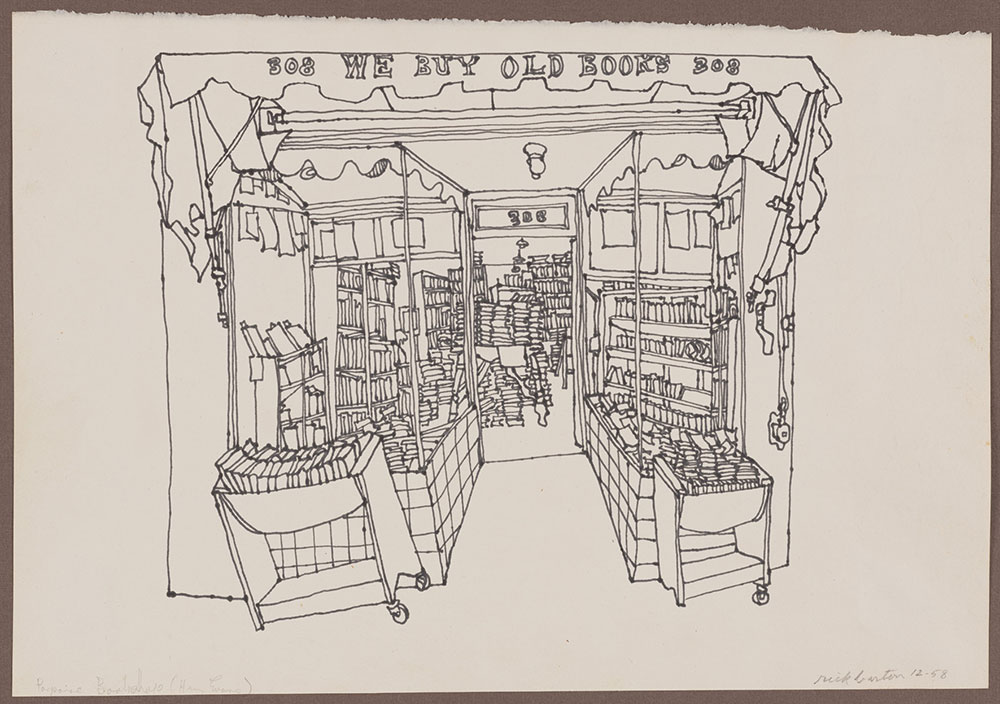Introduction
Richard William Barton (1928–1992) was born in New York City, and he grew up just a few blocks from the Morgan. A lifelong storyteller, Barton favored anecdotes that emphasize his hardscrabble childhood as a “dead-end kid.” Low on funds, and having completed only two years of high school, the budding artist embarked on an extensive self-guided education at the New York Public Library and the Metropolitan Museum of Art. At seventeen he enlisted in the US Navy, visiting China during his service. The primacy of line in traditional Chinese brush painting had an enduring impact on him.
Barton was discharged from the navy early, following a hospitalization that was likely related to mental illness; he described himself as paranoid psychotic. He relocated to the San Francisco Bay Area in the mid-1950s, at the height of the Beat era. Two decades later, he moved to San Diego, where he remained until his death in 1992. In San Francisco, Barton appears to have intersected with less prominent Beat figures of the day, developing his own cohort of artists and interlocutors. But there are few records of his activities after the mid-1960s, and the life of this unusual artist largely remains a mystery.
Untitled [Self-portrait]

Among the nearly eight hundred drawings by Barton that reside at UCLA, this self-portrait stands out for its naturalistic style. Like the rest, however, it was collected by Henry Evans— an antiquarian book dealer, fine-art printer, publisher, and printmaker—between 1958 and 1962 and donated to the university in 1971. The inscription reads, “For Henry from Rick,” alluding to the close relationship between the artist and his patron.
Rick Barton (1928–1992)
Untitled [Self-portrait], September 21, 1959
Charcoal
Rick Barton papers (Collection 2374), UCLA Library Special Collections, Charles E. Young Research Library, University of California, Los Angeles
Untitled [Signature self-portrait]

Compared to the charcoal sketch nearby, this drawing, which is also a self-portrait of sorts, is far more typical of Barton’s style. It shows the artist signing his name backward on a café table; his regular habit of mirror writing may have stemmed from his admiration for Leonardo da Vinci, whose use of reverse handwriting is widely known. Using a consistently weighted line that borders at times on cartoonish, Barton captured the minutiae of his environment— the zipper on his jacket, a beer mug, a coffee cup, ashtrays, his cigarette pack and matches—from an unstable and shifting perspective.
Rick Barton (1928–1992)
Untitled [Signature self-portrait], 1961
Pen and ink
Rick Barton papers (Collection 2374), UCLA Library Special Collections, Charles E. Young Research Library, University of California, Los Angeles
Untitled [Disarticulated draftsman]

Rick Barton (1928–1992)
Untitled [Disarticulated draftsman], May 11, 1960
Pen and ink
Rick Barton papers (Collection 2374), UCLA Library Special Collections, Charles E. Young Research Library, University of California, Los Angeles
Untitled [Hands]

Hands, which are notoriously difficult to draw, frequently appear in Barton’s work. This sketch, possibly made while the artist was incarcerated, examines a specific gesture from multiple angles. The composition underscores the expressive potential of hands, and its overlapping of red and blue lines suggests movement.
Rick Barton (1928–1992)
Untitled [Hands], 1959
Red and blue pen and ink
Rick Barton papers (Collection 2374), UCLA Library Special Collections, Charles E. Young Research Library, University of California, Los Angeles
Untitled [After Jan van Eyck]

This drawing reveals Barton’s process of visual distillation. On the left side of a folded sheet, he copied a famous fifteenth-century portrait by the Flemish artist Jan van Eyck, using rudimentary hatching and cross-hatching to model the figure. Barton fumbled the proportions, drawing the nose twice. By contrast, a pure contour drawing of the same subject—likely Van Eyck himself—on the right side of the sheet is far more confidently executed. Despite his economy of line, Barton conveyed the sitter’s intense gaze in a sketch so fluid it seems to have made itself, beginning at the collar and trailing off the page’s right edge.
Rick Barton (1928–1992)
Untitled [After Jan van Eyck], 1962
Red ballpoint pen
Rick Barton papers (Collection 2374), UCLA Library Special Collections, Charles E. Young Research Library, University of California, Los Angeles
After Poussin

Rick Barton (1928–1992)
After Poussin, 1962
Graphite and brush and blue ink
Rick Barton papers (Collection 2374), UCLA Library Special Collections, Charles E. Young Research Library, University of California, Los Angeles
Untitled [After Dürer and Hokusai]

The robed man with a walking stick in this drawing references a nineteenth-century woodblock print by Katsushika Hokusai, in which the influential Japanese artist represented himself as an older man. The agrarian setting, however, is borrowed from an engraving by the German Renaissance artist Albrecht Dürer. Barton’s consistent line unifies these disparate sources in a cohesive composition.
Rick Barton (1928–1992)
Untitled [After Dürer and Hokusai], 1962
Graphite
Rick Barton papers (Collection 2374), UCLA Library Special Collections, Charles E. Young Research Library, University of California, Los Angeles
Untitled [Porpoise Bookshop, San Francisco]

Henry Evans opened the Porpoise Bookshop, shown here at its second location on Clement Street in San Francisco, in 1953. The store housed the Peregrine Press, which Evans had established four years earlier. From 1958 to 1963, he printed more than a dozen of Barton’s linocuts under the bookshop’s imprint, in editions of between 50 and 120.
Rick Barton (1928–1992)
Untitled [Porpoise Bookshop, San Francisco], December 1958
Pen and ink
Rick Barton papers (Collection 2374), UCLA Library Special Collections, Charles E. Young Research Library, University of California, Los Angeles